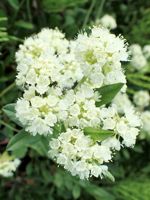Mon-Fri 9am - 5pm Mountain time
Sulphur-Flower Buckwheat vs Alpine Bluegrass
Eriogonum umbellatum
Poa alpina
CUSTOM GROW
CUSTOM GROW
Sulphur-Flower Buckwheat is a native perennial wildflower known for its dense clusters of cream to yellow flowers. The long-lasting blooms persist from late spring into summer, providing an extended nectar source for a variety of pollinators. The flower buds are often red-tinted before opening. As the blooms age, they shift to orange or red, adding seasonal interest and making them well-suited to dried flower arrangements. Its seeds are also eaten by birds, adding to its ecological value.
Depending on climate and conditions, Sulphur-Flower Buckwheat may be evergreen to semi-evergreen, or its foliage may turn red during fall. Its deep roots and spreading growth stabilize rocky or sandy soils, making it useful for erosion control. Exceptionally hardy once established, it requires little care and thrives in challenging environments, making it an excellent choice for pollinator gardens, naturalization, and ecological restoration projects.
Alpine Bluegrass is a native perennial bunchgrass adapted to cold, high-altitude, and northern environments. It establishes well in harsh mountain and tundra conditions, thriving even in nutrient-poor soils. Its dense tufts provide reliable ground cover in alpine and subalpine habitats.
Hardy and low-maintenance, Alpine Bluegrass is valued in revegetation and erosion control projects due to its strong root system. It provides forage for wildlife and livestock, while its dense growth also offers cover for small animals. Well-suited for reclamation and soil stabilization in high-elevation and northern regions, Alpine Bluegrass is a key species for strengthening fragile landscapes, though it is also found in lower-elevation sites.

